







 |
 |
 |
 |
 |
 |
 |
 |
Doom's rise and fall is told in twenty appearances (double the Mole Man's ten).

Every appearance matters, builds on the last, and develops his character. Each is discussed at length in the main issue reviews. They fall into five periods:
Doom, the person
Doom is the primary mirror for the Fantastic Four, and Reed in
particular. Like Reed, Doom's life is dominated by four
themes:
Also like Reed, Doom's arrogance is finally humbled by a child.
Doom as mirror
Doom serves as a mirror for all the major characters:
Doom's initial plan was to rule the world, but this only lasted until he had exhausted all the obvious methods. Then it became clear to him that the FF would stand in his way. Worse, by that time (the late 1960s) there were so many other heroes in his way that he needed a different strategy. His strategy was then to build a power base in Latveria first - see the attached scan from 247 for example. Note that this does not change Doom's self image as "better than anybody." So if an opportunity arises (e.g. the Beyonder) he will still go after raw power, be that conquering the world or whatever. But that is only if an unexpected opportunity arises. His default strategy is to strengthen his power base for the long term.
Note that in Marvel Time only a couple of years passed between his lowest point (the early 1970s) and his story's conclusion (the late 1980s).
His initial phase: try every method to control the world.
Doom matures in responsibility
and morality
At this point he has tried every strategy: a team up (FF6), high
tech (FF10 and 39), divide and conquer (annual 2), force of
numbers (Annual 3), and raw power (ff57). Every strategy EXCEPT
RULING LATVERIA has failed, so it seems clear that he now focuses
on Latveria as his strategy. Note that by this time the world has
many heroes, not just the FF, so attacking the heroes is a worse
strategy than ever. he will never admit to himself that he's but
his goal on the back burner, but judge him by his actions.
Click here for a summary of Doom in other comics at this time. This fills in the back story and confirms how his character evolves.
His lowest point
Like Reed, Doom takes a long time to learn his lesson. He still
maintains the childish need to be acknowledged, and loses his
focus on Latveria. Instead of focusing on the one area where he
can succeed, Latveria, he focuses on his defeats. These defeats
are a major dent to his confidence. The next time we see him
(FF116) he's just brooding. Arguably his brain is also addled for
years by the Power Cosmic.
He still resists putting Latveria first, and so there follows his weakest period - various silly attacks in other books. His lowest point was in Super Villain Team Up, where he acknowledges that his lack of attention to Latveria is the cause of his weakness.
One last try to mind-control the
world
In the final Super Villain Team Up (issue
14), Doom believes he has found the perfect mind-control
device. It is not clear how much of the world is affected, but the
Fantastic Four and X-men are away and presumably unaffected. The
mind-control relies on a gas, so presumably has limited range. The
Beast and Ghost Rider (in the conclusion in Champions 16) are
resistant, and Doom is soon defeated. He seems to consider this
attack inconclusive, and refines it for his second attempt in
FF143. But he already finds mindless obedience unsatisfying (his
ego craves conscious respect). This story foreshadows the more
complete conclusion in Emperor Doom.
No more direct attacks on the FF
His final defeat as world
conqueror
From now on he will only use partners that share his exact mind: specifically, Doombots and Kristoff. Except for short term usage - e.g. Terrax was dumb and only had to be controlled for a day or so.
Latveria finally loves him
Secret Wars - gets Beyonder's power, but could not handle it.
There are two possible endings to Doom's story. Does he learn? FF 330
shows the nightmare scenario: Doom's madness (from issue 200) and
frustration lead to a spiral of war and ultimately the end of the world.
But that is just a dream, just one of many possible futures. There is
also a different future, a hopeful future.
Emperor Doom: he finally sees
sense
In this story Doom obtains a hair from the Purple Man, a being with an unusually effective form of mind control. Doom is able to quietly create a better mind control device than before, and crucially he manages to avoid the Fantastic Four, and develop his plans sufficiently in secret that the Avengers are too late to stop him. Doom has finally almost matured, so instead of reveling in his power (as he did when he rules Microworld) he simply makes the world a better place. Except for the lack of free will thing.
Note that, as with the Beyonder, this was a lucky break and not something Doom could have planned. The Purple Man (Zebadiah Killgrave) taunts Doom that he doesnít deserve to rule, that only Killgraveís own power allows his plan to succeed.
Inevitably one hero (Wonder Man) escapes Doom's influence, frees the others, and Doom is defeated. This is the point where Doom admits to himself that he does not want to rule the world. Not that way anyway. His psychological need is for people to acknowledge him, and that cannot happen if they have no free will. Latveria in FF246 is the only time he ever achieved that: genuine respect. Latveria is his natural home.
Finally neutralized as a major threatThe point is that Doom does not randomly attack. His story has a direction, a purpose, a logic, a beginning middle and an end. His "control the world" period only lasted long enough to see that it didn't work. Note that he mellows in this time: the first time he rules a world (Microverse) he wanted to give pain for its own sake. The first time the FF visited him in Latveria the people lived in terror. But by 246 the people genuinely loved him.
Note that the Doombot hypothesis can be rejected.
This controversial story is from Super-Villain Team Up 7, half way through the 14 issue run where he begins by thinking he can rule the world and ends by wondering if he really wants to: it is thus a microcosm of his full 28 year story. Many consider this as the worst Doom Story ever, but seen in the context of his career it is one of the best: only when we see Doom as he sees himself can we really understand his character:
This is the only time we see him admit a genuine error of judgment and of character.
He identifies Latveria as the key to his success: when he puts them first he succeeds, when he neglects them he fails. In SVTU his honor is at its lowest and he's a pathetic. He's defeated and left for dead by the Shroud, a guy who even admits he's a newbie! But when he puts Latveria first (as in FF84-86), even when he loses he is magnificent.
We see what happens to the moral judgment of a ruler with an inferiority complex who is surrounded by yes-men. Yes, Doom has an inferiority complex: otherwise why is he dominated by the need for others to say they respect him? We see his desperate need to feel powerful - even to the extent of forcing his will on a girl.
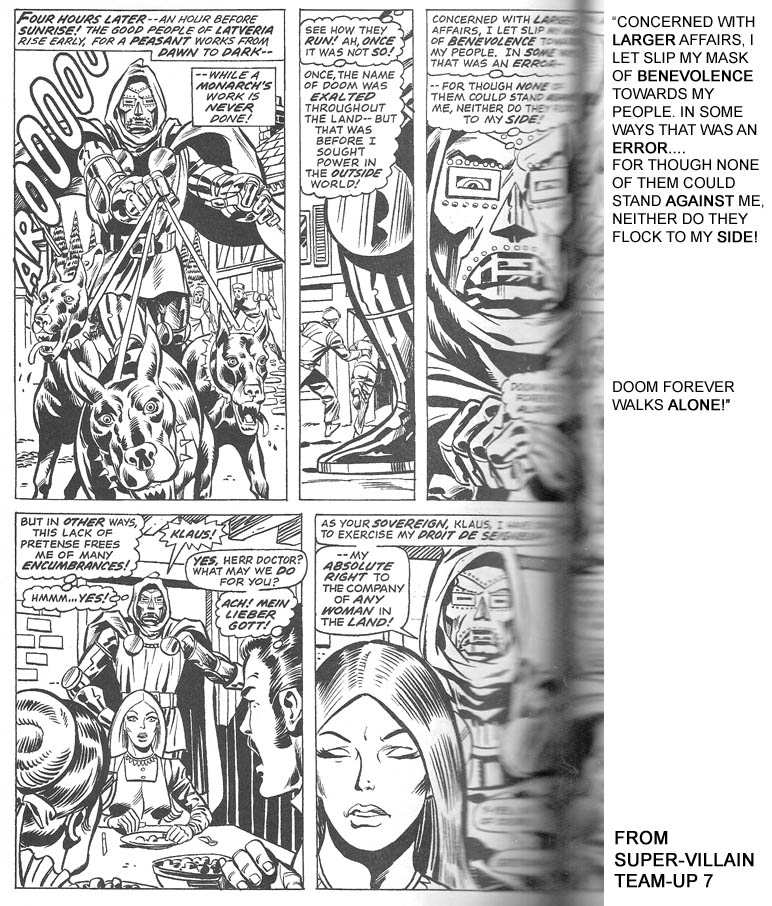
Don't worry, the girl was never
harmed:
"I can't see him actually trying
to get into an intimate moment with some random girl...anytime
there was a chance of him getting close, he would be reminded of
his perceived disfigurement. He got agitated when Alicia touched
his face in the Wolfman arc. Much earlier in Astonishing Tales
he didn't force himself on the Valeria impersonator that
Rudolpho used against him even thought she was in the thrall of
some kind of hypnotic machine. He even had an illusion projector
of some kind to make him look as he had before the accident.
Many years later, Priest wrote a very intriguing tale where yet
another Valeria double brings up some painful reminders of the
past and the lack of her companionship in his life." - Iron Maiden
The old Dr Doom was interesting because he was like us. He had weaknesses. But in 1991 (or thereabouts - around FF 350) Walt Simonson introduced a new, shiny Doom who has almost no weaknesses. Like everything Simonson does it was a great story on its own. But like most post 1991 stories it doesn't have any other layers. The old Doom had depth - he made mistakes and got frustrated. The new Doom is one dimensional. Doombots, like Doom, were never as perfect as he claimed, as wee see a few issues later in the 30th anniversary issue. FF358:
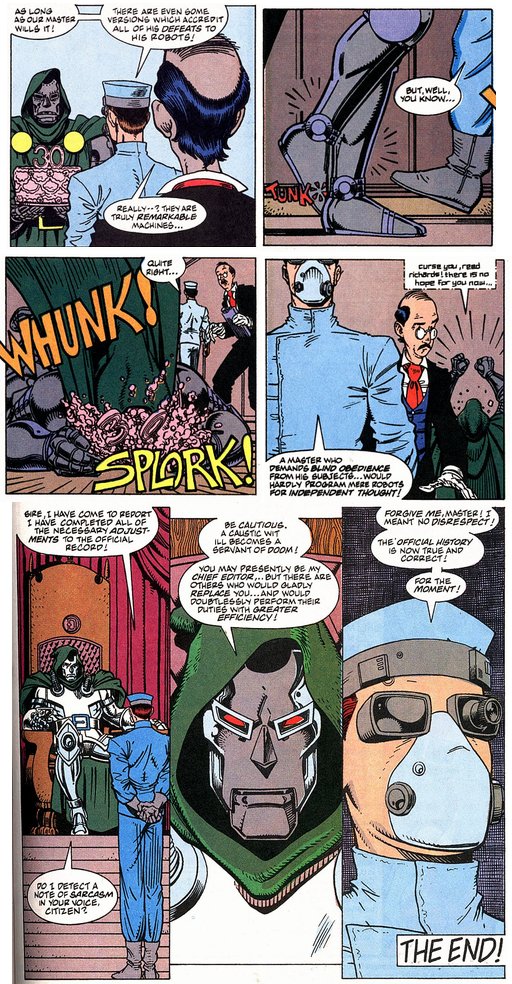
Doom and Squirrel Girl
Talking of weaknesses that he won't admit, remember when Squirrel
Girl defeated him? OK, that was 1991, post Marvel Universe, but
it's possibly the last time we saw Stan ad Jack's
not-as-perfect-as-he-pretends Doom. It may reveal an interesting
take on his moral code - he won't hurt animals, won't use full
force against a girl, and was completely caught off guard but a
situation he never planned for. Has Doom ever hurt an animal? It
is possible that his gypsy upbringing gives him special respect
for non humans. After all, Doom would see well trained animals as
perfect examples of what all humans should be. Except himself of
course. Remember the pet tiger he had in his first appearance?
Doom also has an arrogance that will not let him believe that anyone he sees as weak could defeat him. Couple, this with Squirrel Girl's always underrated powers (which are another topic!) and we can see how she defeated him psychologically. The one thing that Doom cannot cope with is silly humiliation.
For how the Mole Man's ten appearances reflect racism and the underground in America, see the notes to issue 1.

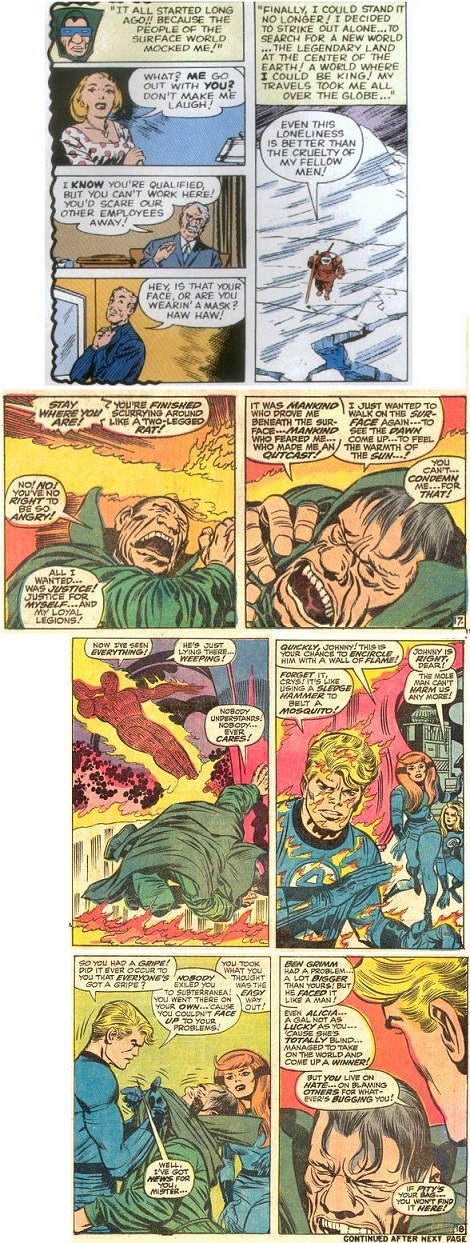
The Mole Man also represents hour hidden insecurities.
"More readers than would admit
could identify with the Mole Man. What adolescents didnít have
some defect they considered a major malfunction or
disfigurement? Of course, most of us were content to stay
indoors and bury our blemished faces in comics rather than seek
vengeance on the surface world." (Robert Papetti,
"Fantastic Four In The Silver Age Sixties: A Tribute")
Have you ever been lonely? Really, truly alone, so that "nobody understands me" and "nobody likes me" are more than just empty whining? The Mole Man is the loneliest character ever created. Hated by everyone, surrounded by millions (probably billions) of loyal followers, but not one of them can engage in intelligent conversation. He has an empire that's bigger than the surface area of the Earth, yet is crushingly alone. Of all the billions who live on the surface, not one has the common decency to treat him like a human being. I think his hatred of the surface world is entirely rational.

In FF 90, Johnny has so sympathy, because he says Ben Grimm had bigger problems. But that isn't true. Ben Grimm never lost his friends. Nobody ever laughed at him. Nobody ever denied him a job because of his looks (indeed, Ben's condition makes him the idol of millions!) Alicia's blindness is worse than the Mole Man's, but what is sight compared to friendship? Alicia has always had friends.
It is perfectly true that the Mole Man lacks any social skills. How could he gain social skills when everybody shuns him? Whenever he tries to love someone they betray and mock him (as happened with Kala). It's easy to mock the misfit when you're handsome and popular (as Johnny Storm illustrates). It's easy to criticize others for not trying harder when your own life has been easy. Does that make you morally superior?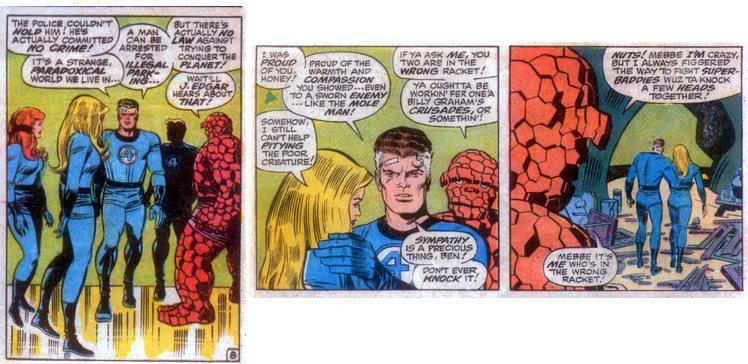
Let us look at the Mole Man's original complaints: He tried to find love, but was mocked instead. He knew he would die alone. He worked to qualify to earn a living, but nobody would hire him. He was already middle aged in 1961, so he grew up in the Great Depression or before. No job means no food. No food and no friends means you die. And in the worst possible way: hated and alone with all your honest effort thrown back in your face.
First appearance: FF1
We don't know many details about his original plan (other than the
highly simplified "they mock me, I destroy them"). However, he
starts by removing nuclear power stations. This has parallels with
his next attempt.
The FF destroy his island in a great explosion. They blame him (FF1) and he blames them (FF22). Why would he destroy his own island? All we know for sure is that the Torch triggered a landslide and there was high tech engineering underneath, so it was almost certainly the FF's fault.
Next appearance: FF22
He plans to harmlessly hide some cities - killing nobody - so that
the paranoid surface world will destroy itself thinking the other
side has attacked. His belief is that surface people kill without
any justification, and his experiment (hide cities and see how
they react) was about to prove him right. The FF again destroy his
island. Note that his plan was to lower cities harmlessly, but the
FF choose destruction instead.
Next appearance: FF31
He is very careful not to hurt anyone until he can carry out his
complete plan. It sounds like the same plan as before - force the
surface people to first show that they are the evil ones.
Once again the torch creates a heat blast that causes a chain
reaction that destroys the Mole Man's home (and no doubt kills
many of his subterraneans). Note that explosions in confined
spaces are far worse than explosions on the surface.
Next appearance: FF88-90
His goal now is simply to be able to come to the surface. But
every time he does that he's hated and shunned. The only way he
can think to do it is to make everyone like he is - almost blind,
so by being blind at last mankind will see. He reveals his overall
strategy - to enrage his enemies so that they destroy
themselves.His enemies follow a pattern: In this story the FF are
in no position to destroy his world, but instead Ben starts to
torture him, while the Mole Man shows no fear.
Next appearance: 127-128
The Mole Man's attack here is cruder - he happily plans to kill
everyone - but only to please someone who pretended to show him
love. It was never about revenge or conquest, it was always about
loneliness.
Next appearance: FF annual 13
Here the Mole Man makes his peace with the surface world, and
creates an underground utopia. As letters to the Fantastic Four
recognize, his character has developed and moved on.
Next appearance: 263-4
The surface world attacked and destroyed his utopia. Remind me,
who is the villain here?
The Mole Man, with more restraint than any other human should have shown, accepted the Fantastic Four's explanation and helped them.
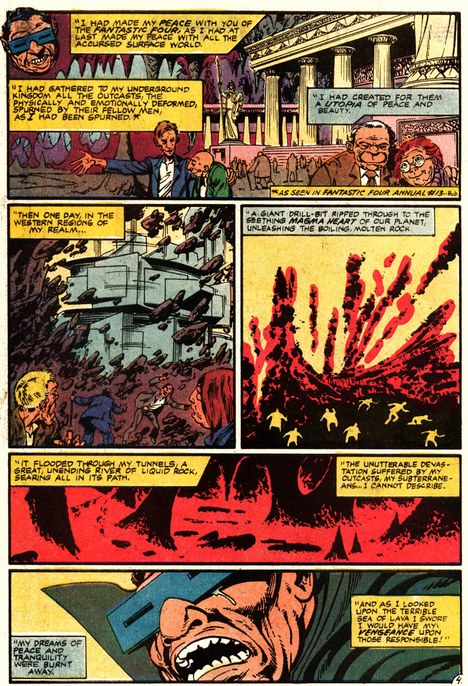
Next appearance: 296
Here Ben Grimm befriends the Mole Man - and betrays him. The Mole
Man wants to help others: his motives are entirely unselfish, so
he tries again to build an island. He tried ordinary islands twice
before, but each time the Fantastic Four destroyed them. They do
the same this time: causing his island and tunnels to collapse.
Surely there must have been deaths. Count he body bags: whatever
the Mole Man has done to the surface world (very little), the
surface world has done far worse to him.
The Mole Man is not attacking anybody, he is helping people by creating a new island. Reed thinks his new island will cause the west coast of America to sink. Ben was already looking for answers regarding the Mole Man's machine, and the Mole Man is desperate for Ben's friendship. So Ben would have persuaded the Mole Man to find a different way, had Reed not been there.
What would you do if you were the Mole Man? Driven underground, then having your home flooded with magma? Would you stay underground and await death? or try to make your own land on the surface, even if the only way was to risk the surface people experiencing their own medicine? It is hard t see the Mole man as any more evil than the people who caused all his problems.
Final appearance: 313Here we see the Mole Man from the other side: the native subterraneans. They love him. He protects them (the only time many died was when Kala controlled Mole Man's life). They need him, and when the FF drive him away then the subterraneans die. We also see in this issue that despite all his disappointments, the Mole Man is willing to give mankind another chance. He doesn't hate the surface world. The Thing, now leading the Fantastic Four, is his friend. The Mole Man is no longer an enemy. He's just a lonely man.
We may see the Mole man as evil - trying to kill everyone on Earth - but his strategy is always to simply unleash our own natural evil, and then he will clean up. he does sometimes try to fit in - before going underground, and after FF annual 13 for example, but the surface world always attacks him.
Even at his worst, even when he threatens the entire world, we should remember just one thing: any one of the billions of humans could have prevented all that destruction, by just treating him as a human being.
No comic character is mocked more than Paste Pot Pete, so I want to stand up for him.
Peter Petruski is a tragic character: this is a story of a man coming unglued: of a brief rise, and long decline and complete loss of confidence.


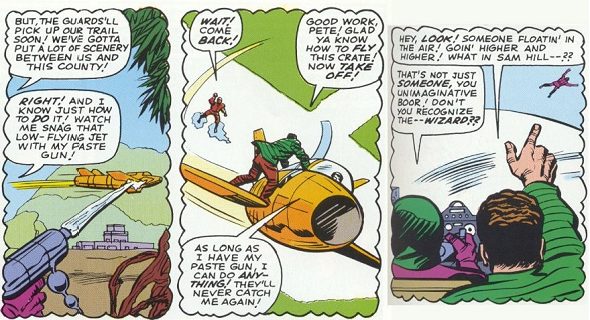
The following is adapted from a debate on comicboards.com
CRITIC: Lee and Kirby created a fair amount of garbage characters, I recently read the stories that introduced Trapster and Wizard and I thought those stories were poorly written and those characters were dull and one dimensional, from day one.
ME: I like the old characters because I find them more rewarding to analyze. And because they were so cheap we could all join in the fun. The corny dialog sounds really strange to modern readers, but it's no less realistic than the heightened cinematic dialog we have now. The corny dialog was only a way to explain and simplify their instant thought processes. Given that both kinds of dialog have to be interpreted, I find the old expository style is more efficient at telling a story. It was established in the comics that what we read was the "real" story as filtered by Stan and Jack (as reporters) who exaggerated it to make it more fun. The technology was less sophisticated and therefore more believable than modern comic tech. And I think foolish villains are more believable than hyper confident villains. Paste Pot Pete is just like a street kid who finds a gun. Somehow he comes into possession of a special gun and he thinks this makes him invincible, so he becomes an idiot show off, and is soon taken down by someone with more experience. One dimensional characters have their place. E.g. Sherlock Holmes was two dimensional and Dr Watson was one dimensional. The original Paste Pot Pete had potential - there were hints of a foreign origin and he had more common sense than the Wizard. It looked like he might learn from his mistakes. But with every story he became a weaker character. By Byrne's run he was established as a joke (he couldn't even invade an empty building without falling over a roller skate).
CRITIC: invading a military base to steal missile plans, which only worked because your average American soldier in the Marvel Universe has the IQ and the reflexes of a rock.
ME: I'm probably biased because I used to work at a military research base (staffed by civilians), and I can imagine someone getting in with enough planning. Pete planned his first campaign in great detail. I also live near a nuclear plant, and it was only a few years ago that they added concrete barriers - until then there was only a flimsy wooden arm blocking the main entrance. I'm guessing that security would be even worse back in 1962.
CRITIC: a glue gun!
ME: His glue gun is a thicker version of Spider-Man's web shooter. Look at Paste Pot Pete's first appearance: The paste expands on contact with air, and escapes with explosive velocity. Just like web fluid. (The splashes on the paste bucket are clearly for show - the actual container is no doubt sealed.) The paste sticks to stuff (obviously), just like web fluid. Spider-Man's web fluid was sometimes used as glue in the early days. The paste is often (mostly?) used as a high strength rope, just like web fluid. The paste dissolves in about an hour or less, just like web fluid. Both web fluid and paste appeared at about the same time in 1962.
CRITIC: Why did Paste Pot Pete never tried to market his glue, like Spidey did ASM 18? Sure Spidey failed to convince them to buy it because it dissolves in an hour
ME: So does Paste-Pot Pete's. For more about superhero technology click here.
CRITIC: Where did he get the glue?
ME: We are not told, but we can guess. Spider-Queen had a crude version of Spider-Man's webbing in 1941. If it dissolved quickly or required great skill to use then it may have appeared useless to other people. Both Paste Pot Pete and Peter Parker were expert chemists. We see Parker in a science lab (when he's bitten) and it's clear that Peter is highly interested in such labs. We are also shown that his early webbing was better than his later stuff, suggesting that he got it from somewhere else.
CRITIC: If we say that Spider-Man and Paste Pot Pete both got their technology from elsewhere then we minimize their accomplishments.
ME: I see it the other way around. To understand and develop alien technology requires great genius. But web shooters are so advanced that for one person to invent it all is effectively impossible. If someone claims the impossible then the story cannot be taken seriously, and that's less impressive.
CRITIC: Plot and characterization is more important to me then how real the science is supposed to be.
ME: That's fine. Most people agree with you. But for me, plot depends on context, so the context has to be believable.
CRITIC: Trapster puts a bad costume and a glue gun and is stupid enough to think he can beat super heroes.
ME: The Torch was easy to beat in the early days - even a bucket of water could stop him. It's clear from the first issue that the glue did have some limited fire protection. so it was a rational decision to confront him.
CRITIC: What made him to decide to become a super villain?
ME: Based on Peter Parker's experience we can assume that he
failed to sell his dissolving glue. Based on his statements we can
assume that he expected a lot of money from crime. Based on his
later statements it seems clear that he wants to prove his self
worth. Each of these things - rejection, profit, self esteem, are
more than enough to explain his actions IMO.
For more about "Strange Tales" see the commentary to issue
36.
